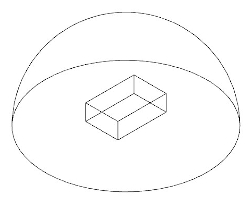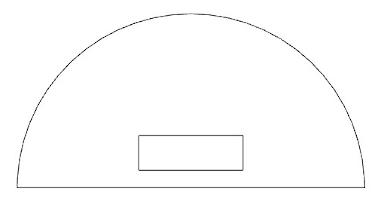- Thank you received: 0
Help with Example Electrostatics Model
5 years 7 months ago #2447
by jleman
Help with Example Electrostatics Model was created by jleman
Hello, I am trying to model a simple 3D electrostatics problem. A metallic object at 1 Volt is surrounded by air and is positioned above a ground plane. The upper part of the dome is a "distant surface" air boundary. My objective is to obtain a result containing the surface charge density at each mesh node on the surface of the energized object. A .step CAD file is attached (dome.step). Since I don't care about anything internal to the cuboid, the volume consists of a dome with a cuboid void.
I normally use the netgen gui to mesh and export to Elmer Format. However, I learned that this could be done in ngsolve with scripting.
I have been able to get as far importing the .step file and meshing the object (code below). The imported step file has surfaces: 1 = air boundary, 2 = ground plane, 3 through 8 = cuboid.
Could someone point me in the right direction or give example scripts that show:
I'm really stuck on the first item. I might be able to find the other three if I can get that one figured out, but if the others are quick for someone to point out, I would really appreciate the assistance. Thanks!
.
.
I normally use the netgen gui to mesh and export to Elmer Format. However, I learned that this could be done in ngsolve with scripting.
I have been able to get as far importing the .step file and meshing the object (code below). The imported step file has surfaces: 1 = air boundary, 2 = ground plane, 3 through 8 = cuboid.
Could someone point me in the right direction or give example scripts that show:
- How to name boundaries (I would like to set the air boundary to bc 1, ground plane to bc 2, and energized surfaces to bc 3.
- How to assign potentials to a bc
- How to assign a Nuemann boundary condition to the air boundary
- How to solve and get an output with the charge density at the surface nodes of the energized cuboid
I'm really stuck on the first item. I might be able to find the other three if I can get that one figured out, but if the others are quick for someone to point out, I would really appreciate the assistance. Thanks!
.
.
Code:
from netgen.occ import *
geo = OCCGeometry('C:/Temp/dome.step') #import step file
for x in range(2,8): #iterate through surfaces of cuboid
geo.SetFaceMeshsize(x,25) #set mesh size for cuboid surfaces
geo.SetFaceMeshsize(0,100) #set mesh size for air boundary
geo.SetFaceMeshsize(1,25) #set mesh size for ground plane
mesh = geo.GenerateMesh(maxh = 100,grading = 0.75) #mesh the volume with prescribed size and grading
mesh.Save('C:/Temp/dome.vol') #save mesh out
Attachments:
- mneunteufel
-
- Offline
- Premium Member
-

Less
More
- Thank you received: 59
5 years 7 months ago #2449
by mneunteufel
Replied by mneunteufel on topic Help with Example Electrostatics Model
Hi jleman,
1)
you can set materials (1 based index) by
and boundary conditions by
2)
For setting non-homogeneous Dirichlet boundary conditions I recommend this tutorial and this .
3)
Neumann boundary conditions should be straight-forward with 2). For homogeneous Neumann conditions you mostly have the "do-nothing" conditions, otherwise it goes naturally into the right-hand side of your problem.
4)
The tutorials in 2) should be a good starting point here.
Best,
Michael
1)
you can set materials (1 based index) by
Code:
mesh.SetMaterial(int, string)
Code:
mesh.SetBCName(int, string)
2)
For setting non-homogeneous Dirichlet boundary conditions I recommend this tutorial and this .
3)
Neumann boundary conditions should be straight-forward with 2). For homogeneous Neumann conditions you mostly have the "do-nothing" conditions, otherwise it goes naturally into the right-hand side of your problem.
4)
The tutorials in 2) should be a good starting point here.
Best,
Michael
The following user(s) said Thank You: jleman
5 years 7 months ago - 5 years 7 months ago #2482
by jleman
etc..
Replied by jleman on topic Help with Example Electrostatics Model
- Per your suggestion I ran the code with the SetBCName function applied as shown below. The code runs fine (no errors), but when I explore the mesh boundary conditions in the netgen gui, all boundaries have the name 'voltage' (no 'air' and 'ground' boundaries). Face index 1 and 2 should be 'air' and 'ground' respectively. Suggestions?
- Also, how do I assign a face index to a bc property? In this case I need face index 1 to be bc property 1, face index 2 to be bc property 2, and face indices 3 through 8 to be bc property 3.
etc..
Code:
from netgen.occ import *
from ngsolve import *
geo = OCCGeometry('C:/00_Temp/netgen testing/dome.step')
for x in range(2,8):
geo.SetFaceMeshsize(x,100)
geo.SetFaceMeshsize(0,1000)
geo.SetFaceMeshsize(1,250)
mesh = geo.GenerateMesh(maxh = 1000,grading = 0.75)
mesh.SetBCName(0,'air')
mesh.SetBCName(1,'ground')
for x in range(2,8):
mesh.SetBCName(x,'voltage')
mesh.Save('C:/00_Temp/netgen testing/dome.vol')
Last edit: 5 years 7 months ago by jleman.
- mneunteufel
-
- Offline
- Premium Member
-

Less
More
- Thank you received: 59
5 years 7 months ago #2493
by mneunteufel
Replied by mneunteufel on topic Help with Example Electrostatics Model
Hi jleman,
with the attached code I get also air and ground as boundaries
Output:
boundaries = ('air', 'ground', 'voltage', 'voltage', 'voltage', 'voltage', 'voltage', 'voltage')
Best
Michael
with the attached code I get also air and ground as boundaries
Output:
boundaries = ('air', 'ground', 'voltage', 'voltage', 'voltage', 'voltage', 'voltage', 'voltage')
Best
Michael
Attachments:
The following user(s) said Thank You: jleman
5 years 6 months ago #2551
by jleman
Replied by jleman on topic Help with Example Electrostatics Model
Is there a way to get the following information from the electrostatic model once it has solved?
1. x,y,z coordinates of all nodes
2. surface charge density calculated for surface node of the energized block
1. x,y,z coordinates of all nodes
2. surface charge density calculated for surface node of the energized block
5 years 6 months ago #2553
by jleman
Replied by jleman on topic Help with Example Electrostatics Model
I noticed that the .vol mesh file saved after naming the boundaries does not seem to properly retain the data. When I open the .vol file manually with the netgen gui then go to mesh=>edit boundary conditions, all the boundary names say 'voltage'. If I move the
line so that it is the last of the boundary naming entries then all boundaries show up as "ground". Is this a bug?
Ultimately I am trying to export the mesh to an elmerfem format then user elmer to solve the electrostatics problem and get a result that contains all the node x,y,z locations and surface density values at each node. Perhaps it would be easier to do all that from within ngsolve?
Code:
ngmesh.SetBCName(1,'ground')
Ultimately I am trying to export the mesh to an elmerfem format then user elmer to solve the electrostatics problem and get a result that contains all the node x,y,z locations and surface density values at each node. Perhaps it would be easier to do all that from within ngsolve?
Time to create page: 0.135 seconds








